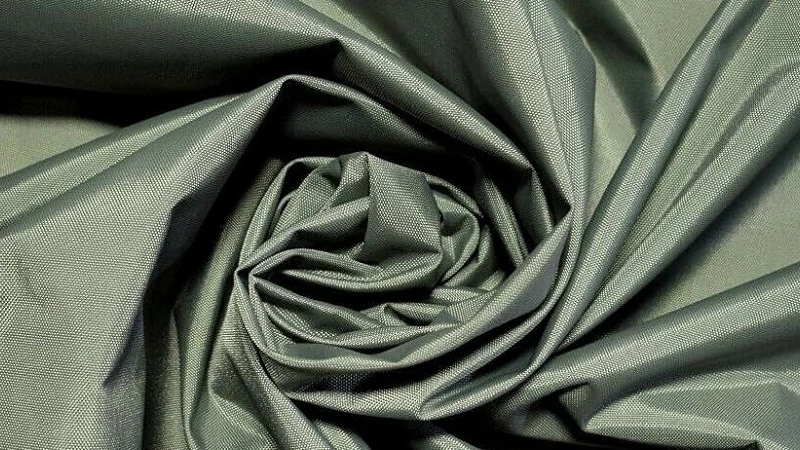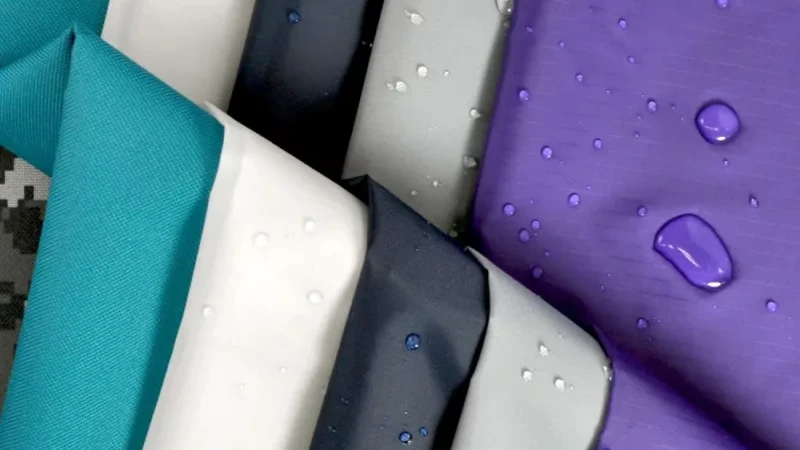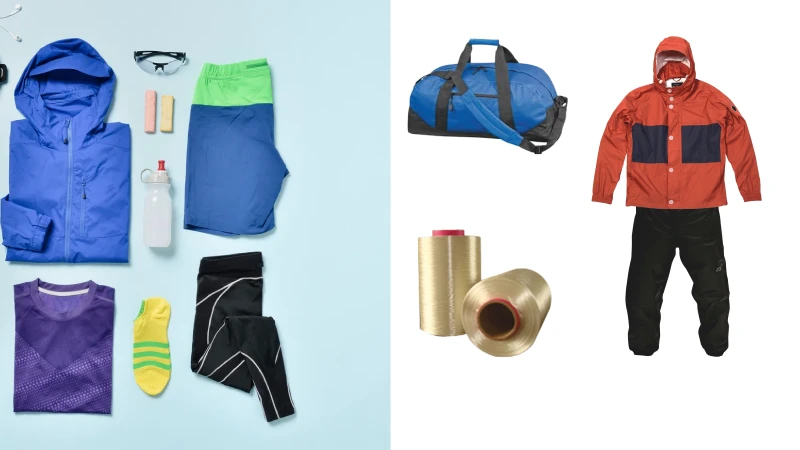Nylon isn’t new, but it’s far from outdated. Since its invention in 1935 by DuPont, nylon has revolutionized the textile industry—and it continues to play a central role in modern material science and product design. Whether you’re in manufacturing, design, or simply interested in smart materials, understanding the advantages of nylon fabric will change how you view synthetic textiles.
As a textile manufacturer, we’ve worked with every type of material—from natural fibers like cotton and silk to synthetics like polyester and rayon. Nylon stands out. It combines technical brilliance with tactile comfort, offering benefits that make it a top choice across industries, from fashion and automotive to industrial and sportswear applications.
This guide isn’t just theoretical—we’ll back our claims with real-world usage, industry insights, and references from reliable sources like OEKO-TEX standards, and REACH compliance frameworks.
Let’s explore what makes nylon such a powerhouse fabric.
What Is Nylon Fabric?

According to Wikipedia, nylon is a synthetic polymer made through a process called condensation polymerization. It was the first fabric entirely developed in a laboratory and has been used widely in commercial and industrial settings since World War II.
Chemically, nylon belongs to the polyamide family. It’s made of repeating units linked by amide bonds, giving it remarkable strength, elasticity, and resistance to chemicals and abrasion.
Nylon is available in various types (e.g., Nylon 6, Nylon 6,6), each tailored to specific use cases—from industrial ropes to soft, wearable textiles. Today’s nylon fabrics have evolved to become softer, more sustainable, and more adaptable to blending with other fibers.
Exceptional Durability and Strength

One of nylon’s most valuable traits is its incredible tensile strength. It’s engineered to withstand intense wear and tear, making it a go-to material for high-stress applications like climbing ropes, airbags, and heavy-duty upholstery.
According to textile performance benchmarks, nylon can reach tensile strengths up to 700 MPa, significantly higher than most natural fibers. That means nylon products last longer, resist damage, and maintain their structural integrity under stress.
For textile manufacturers, this translates to fewer product failures, higher customer satisfaction, and better cost-efficiency.
Lightweight Composition
Despite its strength, nylon is extremely lightweight. This makes it ideal for products where weight reduction is essential, such as travel gear, sports apparel, and even aerospace components.
In textile manufacturing, lighter fabrics reduce shipping costs and improve user comfort. Nylon’s featherweight nature allows it to be used in layered garments or products without bulkiness, offering freedom of movement and reduced fatigue for end users.
Wrinkle and Shrink Resistance
Nylon is naturally resistant to wrinkles and shrinkage, making it one of the lowest-maintenance fabrics available. This property is a major win for both manufacturers and consumers, as it reduces the need for ironing or steaming and ensures garments retain their shape over time.
Its dimensional stability also means nylon is easier to work with during cutting and sewing, ensuring consistency across large-scale production runs.
Moisture-Wicking and Quick-Drying

Nylon excels at moisture management. Its fibers don’t absorb water easily—instead, they wick it away from the surface, promoting evaporation. This is why nylon is so commonly used in performance wear and outerwear.
This quick-drying property isn’t just about comfort; it also helps prevent mildew and odor build-up, making nylon suitable for use in humid or wet environments.
Resistance to Mold, Mildew, and Chemicals
Nylon’s synthetic composition makes it naturally resistant to microbial growth and many household chemicals. It doesn’t rot or break down in damp conditions like cotton or wool might.
Industries such as marine, automotive, and industrial safety value this trait, as nylon can be used in environments where durability and hygiene are paramount.
Soft, Smooth Texture
While early nylon had a reputation for being stiff or plasticky, modern nylon—especially when finely woven—has a silky, smooth texture that rivals natural fabrics like silk or modal.
This soft hand feel makes nylon ideal for consumer-facing textiles, where comfort is just as important as performance. Its smooth surface also resists pilling, keeping garments and textiles looking newer for longer.
Superior Stretch and Flexibility
Nylon offers excellent elastic recovery, meaning it can stretch and return to its original shape without sagging or deforming. This flexibility is often enhanced by blending nylon with elastane or spandex.
That’s why you’ll find nylon used in everything from yoga wear and swimsuits to industrial fasteners and prosthetics—it flexes without failing.
Brilliant Color Retention
Thanks to its ability to absorb and retain dye deeply, nylon maintains rich, vibrant colors even after repeated washing or exposure to sunlight. Its excellent dye affinity ensures long-lasting colorfastness that natural fibers struggle to match.
This makes nylon an ideal choice for branding, fashion-forward products, and technical textiles where color stability is crucial.
Abrasion and Tear Resistance
Nylon stands up to repeated friction better than most fabrics. This makes it perfect for high-traffic applications such as upholstery, luggage, outdoor gear, and industrial tarps.
Its ability to withstand daily abuse without fraying or tearing significantly extends the life cycle of products, leading to better ROI for manufacturers and greater trust from users.
Low Maintenance and Easy to Wash
Nylon is machine-washable, quick to dry, and doesn’t require ironing—making it one of the most convenient fabrics to maintain.
Unlike wool or silk, nylon doesn’t need special detergents or dry-cleaning. Its hassle-free care is one reason it remains popular in consumer goods, institutional settings, and even uniforms.
Nylon Fabric Uses

1. Apparel and Fashion
Nylon is widely used in clothing due to its stretch, durability, and smooth texture. It’s popular in activewear, leggings, swimwear, lingerie, hosiery, jackets, and raincoats for its moisture-wicking and quick-drying properties.
2. Outdoor and Sports Gear
Its lightweight yet strong structure makes nylon ideal for tents, backpacks, sleeping bags, ropes, and parachutes. It withstands wear, resists tearing, and performs well in extreme weather.
3. Industrial Applications
Nylon is crucial in producing ropes, cords, conveyor belts, safety harnesses, and airbags. Its high tensile strength, chemical resistance, and low friction make it reliable for heavy-duty use.
4. Home Textiles and Furnishings
You’ll find nylon in carpets, rugs, upholstery, and curtains. It offers excellent stain resistance, easy cleaning, and long-lasting performance, making it ideal for high-traffic areas.
5. Automotive and Technical Fields
Used in tire cords, seat belts, airbags, and under-the-hood components, nylon offers heat resistance and structural stability in demanding conditions.
6. Medical and Healthcare
Nylon is used in medical sutures, prosthetic linings, orthopedic braces, and support bands due to its hypoallergenic and hygienic properties.
Nylon Fabric VS Other Fabric
| Feature / Fabric Type | Nylon Fabric | Cotton Fabric | Quilting Fabric | Polyester Fabric |
|---|---|---|---|---|
| Material Origin | Synthetic (petroleum-based) | Natural (plant-based) | Usually cotton or cotton blends | Synthetic (petroleum-based) |
| Durability | Very high – resistant to wear and tear | Moderate – prone to wear over time | Moderate – durable for crafting | High – resists stretching and shrinking |
| Moisture Wicking | Excellent – dries quickly | Low – absorbs moisture | Low to medium – depends on blend | Good – wicks moisture away |
| Softness | Smooth and soft | Very soft and breathable | Soft with a structured feel | Can feel synthetic but smooth |
| Breathability | Moderate – improved in blends | Excellent – allows airflow | Good – typically breathable | Moderate – can trap heat |
| Wrinkle Resistance | Excellent – resists wrinkles | Poor – wrinkles easily | Moderate – holds shape | Excellent – wrinkle-resistant |
| Shrinkage | Minimal | Can shrink if not pre-shrunk | May shrink without treatment | Minimal – retains shape |
| Ease of Care | Machine washable, low maintenance | Requires ironing, may fade | Easy to care for | Easy – machine wash, low iron need |
| Use Cases | Activewear, outerwear, gear, industrial | Everyday clothing, bedding, casual wear | Quilts, craft projects, structured garments | Sportswear, uniforms, home textiles |
| Environmental Impact | Less eco-friendly unless recycled | Biodegradable but water/resource intensive | Depends on fiber content | Not biodegradable, but recyclable options |
| Cost | Moderate to low | Generally affordable | Affordable (depends on cotton type) | Affordable |
FAQ
Is nylon fabric suitable for all climates?
Yes, nylon performs well in a wide range of climates due to its ability to regulate moisture. In warmer weather, its moisture-wicking and quick-drying properties help keep users cool and dry. In colder environments, nylon can serve as a durable, lightweight base layer or outer shell when layered appropriately. Its adaptability makes it ideal for use in everything from tropical gear to winter clothing systems.
Does nylon fabric degrade over time?
While nylon is incredibly durable, like any material, it can degrade with prolonged exposure to UV rays, high heat, or aggressive chemicals. That said, high-quality nylon used in technical applications often comes with UV stabilizers or coatings to improve resistance. With proper care, nylon can maintain its strength and appearance far longer than most natural fibers.
Can nylon be recycled?
Yes. One of the most exciting developments in sustainable textiles is the rise of regenerated nylon. Brands like ECONYL® and REPREVE® produce high-quality recycled nylon from discarded fishing nets, industrial plastic waste, and fabric scraps. This allows manufacturers to create eco-conscious products without sacrificing performance, and supports a circular economy in the textile industry.
How does nylon compare to polyester?
Nylon and polyester are often compared because both are synthetic, but nylon generally offers better elasticity, abrasion resistance, and softness. Polyester, on the other hand, is more UV-resistant and tends to be slightly more hydrophobic. Nylon is the preferred choice in industries where strength and stretch are essential, such as outerwear, technical gear, and industrial fabrics.
Is nylon hypoallergenic?
Yes, nylon is considered hypoallergenic. It doesn’t attract dust mites and is less likely to harbor allergens compared to many natural fibers. This makes it suitable for use in environments where hygiene is a priority—like medical textiles, mattresses, or travel accessories. Plus, nylon’s smooth texture reduces the risk of irritation for sensitive skin types.
Conclusion
In the ever-evolving world of textiles, nylon continues to stand the test of time—not just as a durable synthetic, but as a high-performance, adaptive, and increasingly sustainable material. Whether you’re sourcing materials for fashion, industrial use, medical applications, or outdoor gear, nylon provides a reliable, future-ready foundation.
From its incredible strength and color retention to its resistance to mold, mildew, and moisture, nylon is far more than just a “plastic fabric”—it’s a modern marvel born from chemistry, refined by technology, and trusted across the globe.
So the next time you’re choosing a fabric that needs to last, perform, and impress, consider nylon—not just for what it is, but for everything it can become.
